An Analysis of Road Safety Violations in Singapore: Report
VerifiedAdded on 2020/03/16
|48
|12143
|38
Report
AI Summary
This report investigates the trends and effects of road safety violations in Singapore, analyzing the increasing rate of traffic accidents and their impact on society and the economy. It examines the role of the Singaporean government and the Traffic Police in implementing programs to address these issues. The report includes a literature review that covers national road safety standards, improvements, and statistics, focusing on vulnerable road users like motorcyclists and pedestrians. The research methodology involves data collection from various sources and interviews, followed by data analysis and ethical considerations. The findings discuss the root causes of violations, contemporary mitigation methods, and statistical data on traffic rule violations. New initiatives for improvement and risk assessments are also presented, with recommendations for enhancing compliance levels and reducing accidents. The report aims to provide a comprehensive understanding of road safety challenges and propose effective strategies for improvement.
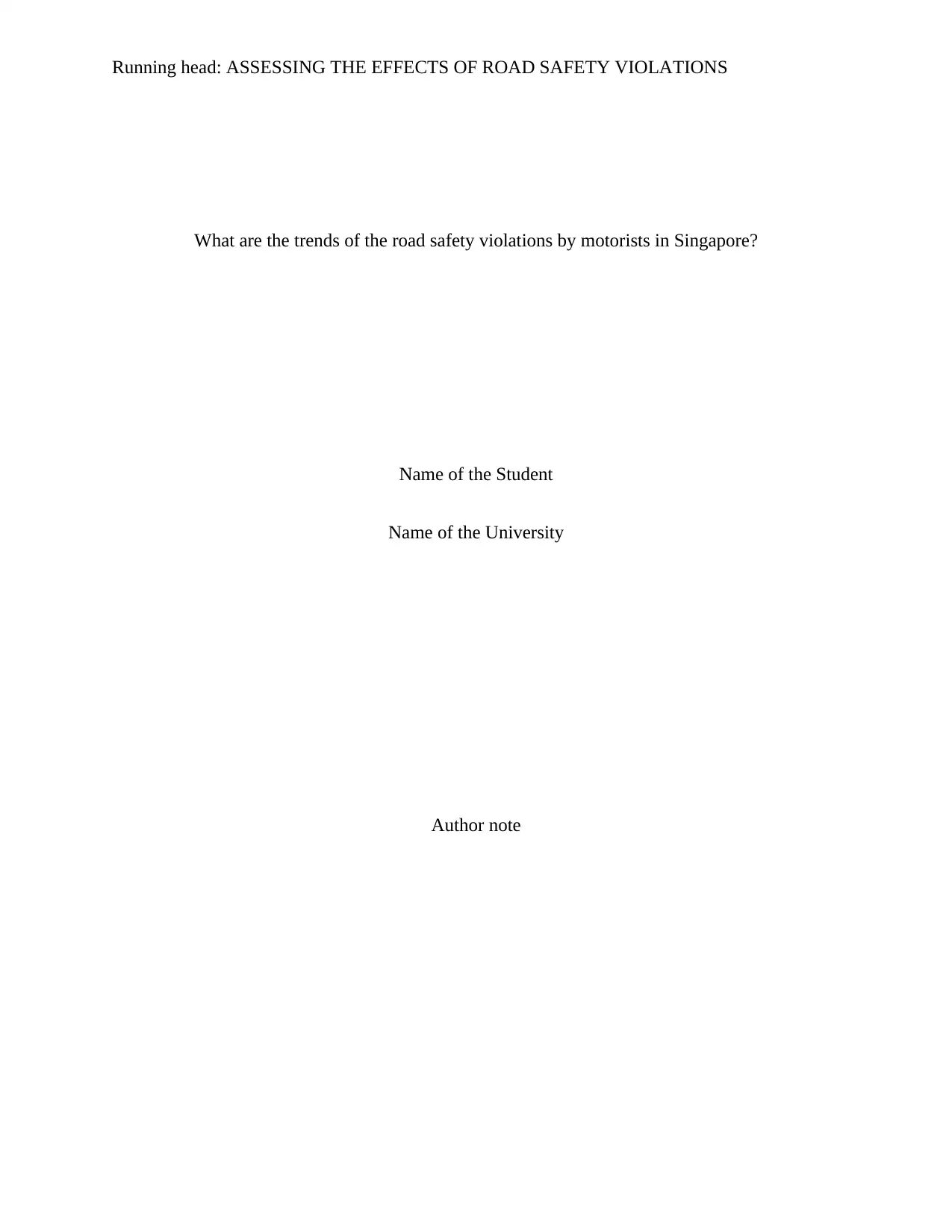
Running head: ASSESSING THE EFFECTS OF ROAD SAFETY VIOLATIONS
What are the trends of the road safety violations by motorists in Singapore?
Name of the Student
Name of the University
Author note
What are the trends of the road safety violations by motorists in Singapore?
Name of the Student
Name of the University
Author note
Paraphrase This Document
Need a fresh take? Get an instant paraphrase of this document with our AI Paraphraser
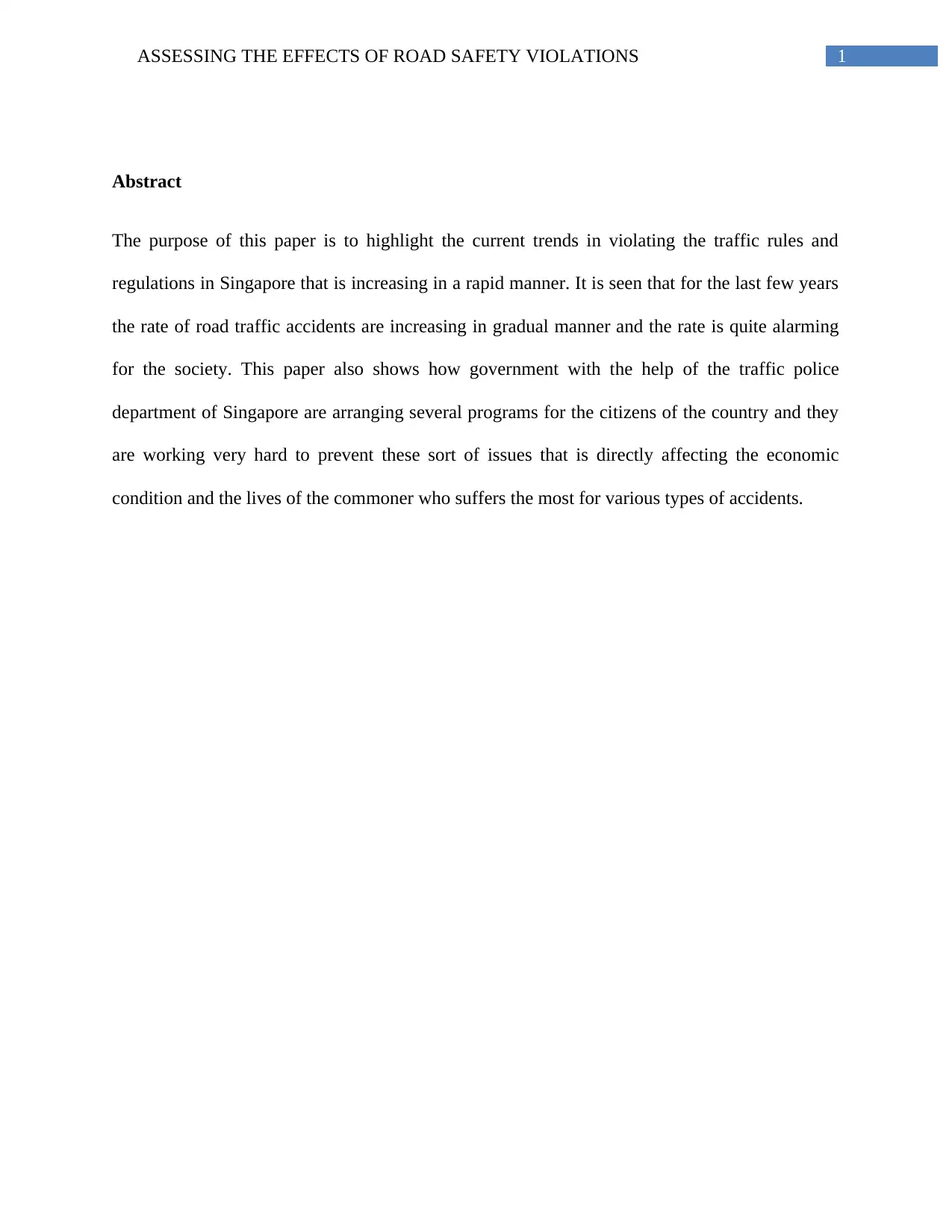
1ASSESSING THE EFFECTS OF ROAD SAFETY VIOLATIONS
Abstract
The purpose of this paper is to highlight the current trends in violating the traffic rules and
regulations in Singapore that is increasing in a rapid manner. It is seen that for the last few years
the rate of road traffic accidents are increasing in gradual manner and the rate is quite alarming
for the society. This paper also shows how government with the help of the traffic police
department of Singapore are arranging several programs for the citizens of the country and they
are working very hard to prevent these sort of issues that is directly affecting the economic
condition and the lives of the commoner who suffers the most for various types of accidents.
Abstract
The purpose of this paper is to highlight the current trends in violating the traffic rules and
regulations in Singapore that is increasing in a rapid manner. It is seen that for the last few years
the rate of road traffic accidents are increasing in gradual manner and the rate is quite alarming
for the society. This paper also shows how government with the help of the traffic police
department of Singapore are arranging several programs for the citizens of the country and they
are working very hard to prevent these sort of issues that is directly affecting the economic
condition and the lives of the commoner who suffers the most for various types of accidents.
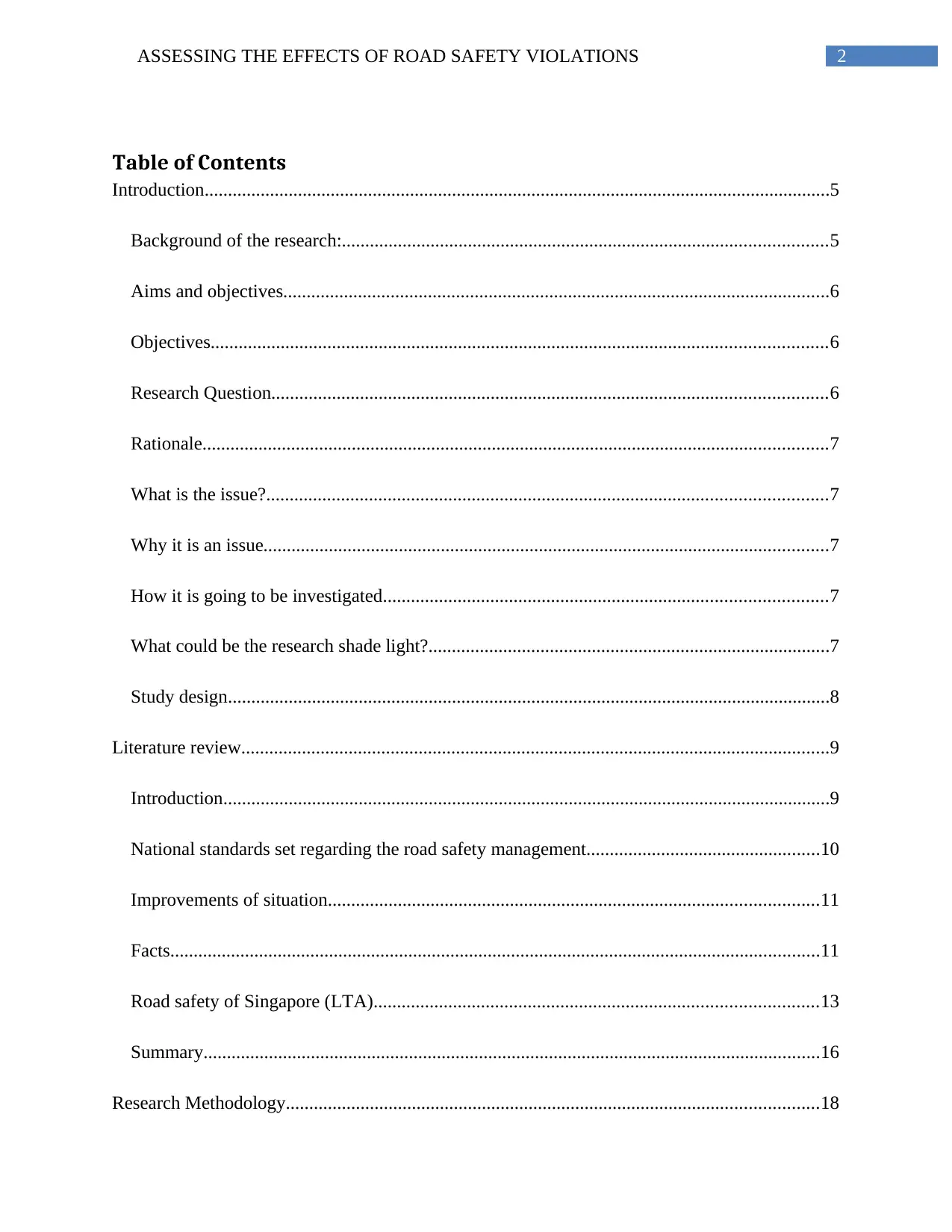
2ASSESSING THE EFFECTS OF ROAD SAFETY VIOLATIONS
Table of Contents
Introduction......................................................................................................................................5
Background of the research:........................................................................................................5
Aims and objectives.....................................................................................................................6
Objectives....................................................................................................................................6
Research Question.......................................................................................................................6
Rationale......................................................................................................................................7
What is the issue?........................................................................................................................7
Why it is an issue.........................................................................................................................7
How it is going to be investigated...............................................................................................7
What could be the research shade light?......................................................................................7
Study design.................................................................................................................................8
Literature review..............................................................................................................................9
Introduction..................................................................................................................................9
National standards set regarding the road safety management..................................................10
Improvements of situation.........................................................................................................11
Facts...........................................................................................................................................11
Road safety of Singapore (LTA)...............................................................................................13
Summary....................................................................................................................................16
Research Methodology..................................................................................................................18
Table of Contents
Introduction......................................................................................................................................5
Background of the research:........................................................................................................5
Aims and objectives.....................................................................................................................6
Objectives....................................................................................................................................6
Research Question.......................................................................................................................6
Rationale......................................................................................................................................7
What is the issue?........................................................................................................................7
Why it is an issue.........................................................................................................................7
How it is going to be investigated...............................................................................................7
What could be the research shade light?......................................................................................7
Study design.................................................................................................................................8
Literature review..............................................................................................................................9
Introduction..................................................................................................................................9
National standards set regarding the road safety management..................................................10
Improvements of situation.........................................................................................................11
Facts...........................................................................................................................................11
Road safety of Singapore (LTA)...............................................................................................13
Summary....................................................................................................................................16
Research Methodology..................................................................................................................18
⊘ This is a preview!⊘
Do you want full access?
Subscribe today to unlock all pages.

Trusted by 1+ million students worldwide
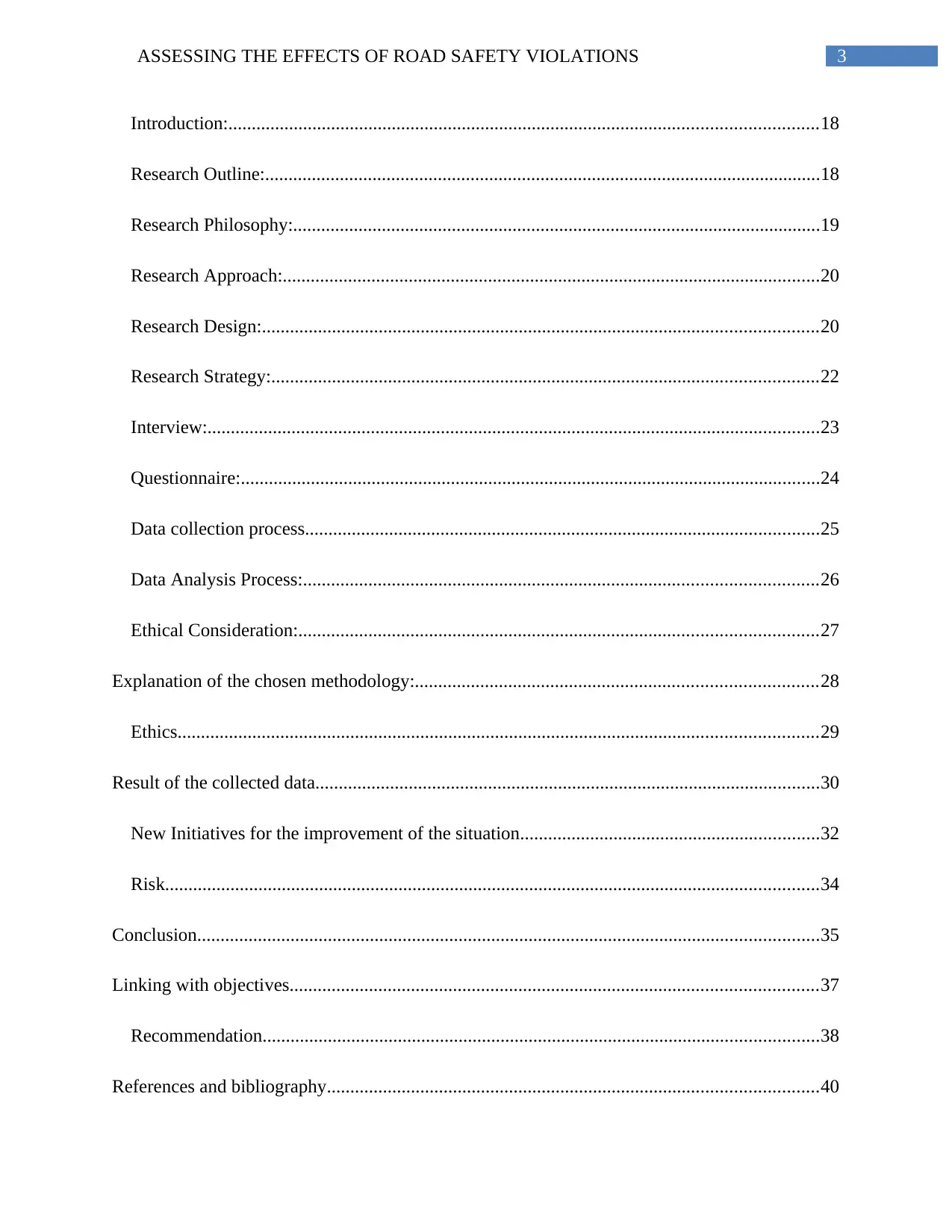
3ASSESSING THE EFFECTS OF ROAD SAFETY VIOLATIONS
Introduction:..............................................................................................................................18
Research Outline:.......................................................................................................................18
Research Philosophy:.................................................................................................................19
Research Approach:...................................................................................................................20
Research Design:.......................................................................................................................20
Research Strategy:.....................................................................................................................22
Interview:...................................................................................................................................23
Questionnaire:............................................................................................................................24
Data collection process..............................................................................................................25
Data Analysis Process:..............................................................................................................26
Ethical Consideration:...............................................................................................................27
Explanation of the chosen methodology:......................................................................................28
Ethics.........................................................................................................................................29
Result of the collected data............................................................................................................30
New Initiatives for the improvement of the situation................................................................32
Risk............................................................................................................................................34
Conclusion.....................................................................................................................................35
Linking with objectives.................................................................................................................37
Recommendation.......................................................................................................................38
References and bibliography.........................................................................................................40
Introduction:..............................................................................................................................18
Research Outline:.......................................................................................................................18
Research Philosophy:.................................................................................................................19
Research Approach:...................................................................................................................20
Research Design:.......................................................................................................................20
Research Strategy:.....................................................................................................................22
Interview:...................................................................................................................................23
Questionnaire:............................................................................................................................24
Data collection process..............................................................................................................25
Data Analysis Process:..............................................................................................................26
Ethical Consideration:...............................................................................................................27
Explanation of the chosen methodology:......................................................................................28
Ethics.........................................................................................................................................29
Result of the collected data............................................................................................................30
New Initiatives for the improvement of the situation................................................................32
Risk............................................................................................................................................34
Conclusion.....................................................................................................................................35
Linking with objectives.................................................................................................................37
Recommendation.......................................................................................................................38
References and bibliography.........................................................................................................40
Paraphrase This Document
Need a fresh take? Get an instant paraphrase of this document with our AI Paraphraser

4ASSESSING THE EFFECTS OF ROAD SAFETY VIOLATIONS
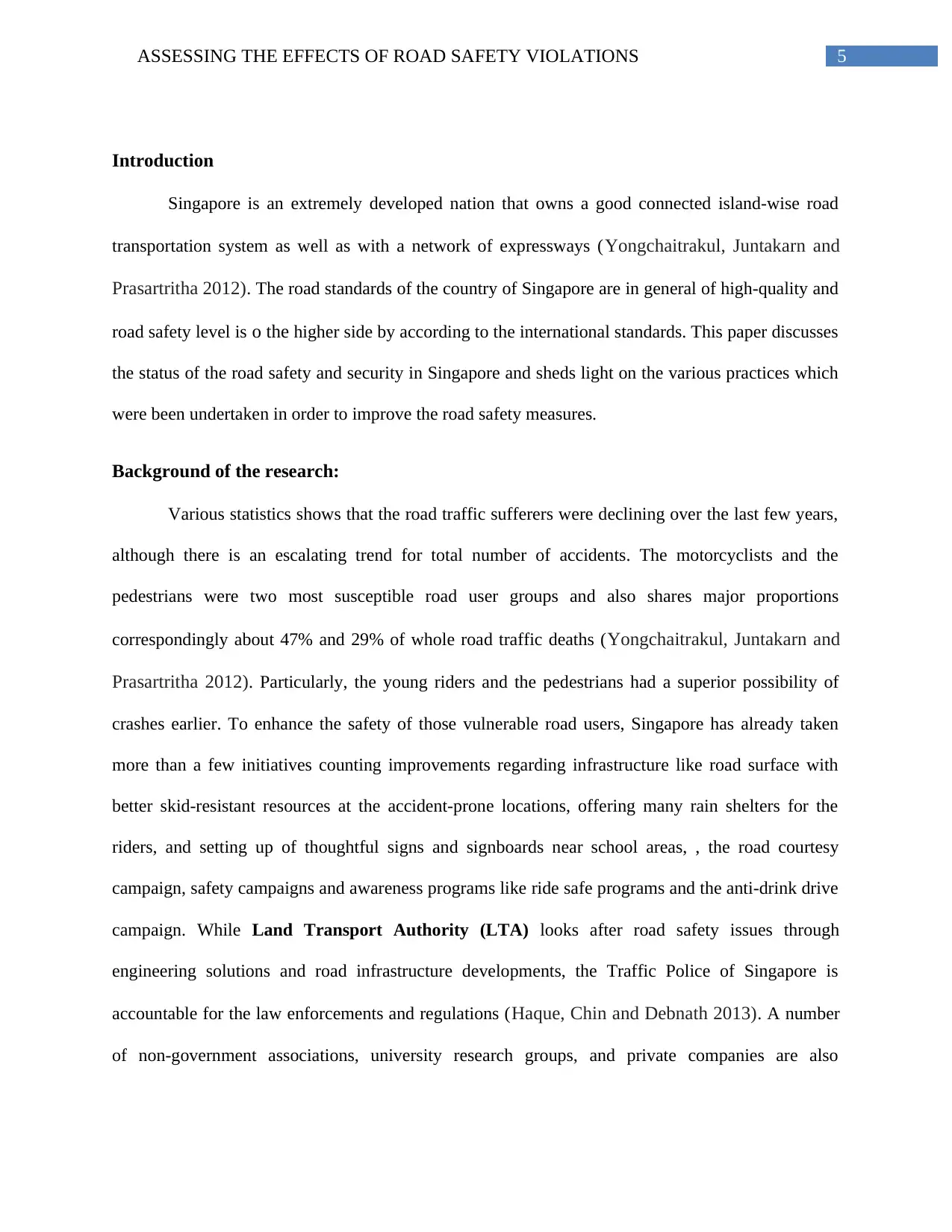
5ASSESSING THE EFFECTS OF ROAD SAFETY VIOLATIONS
Introduction
Singapore is an extremely developed nation that owns a good connected island-wise road
transportation system as well as with a network of expressways (Yongchaitrakul, Juntakarn and
Prasartritha 2012). The road standards of the country of Singapore are in general of high-quality and
road safety level is o the higher side by according to the international standards. This paper discusses
the status of the road safety and security in Singapore and sheds light on the various practices which
were been undertaken in order to improve the road safety measures.
Background of the research:
Various statistics shows that the road traffic sufferers were declining over the last few years,
although there is an escalating trend for total number of accidents. The motorcyclists and the
pedestrians were two most susceptible road user groups and also shares major proportions
correspondingly about 47% and 29% of whole road traffic deaths (Yongchaitrakul, Juntakarn and
Prasartritha 2012). Particularly, the young riders and the pedestrians had a superior possibility of
crashes earlier. To enhance the safety of those vulnerable road users, Singapore has already taken
more than a few initiatives counting improvements regarding infrastructure like road surface with
better skid-resistant resources at the accident-prone locations, offering many rain shelters for the
riders, and setting up of thoughtful signs and signboards near school areas, , the road courtesy
campaign, safety campaigns and awareness programs like ride safe programs and the anti-drink drive
campaign. While Land Transport Authority (LTA) looks after road safety issues through
engineering solutions and road infrastructure developments, the Traffic Police of Singapore is
accountable for the law enforcements and regulations (Haque, Chin and Debnath 2013). A number
of non-government associations, university research groups, and private companies are also
Introduction
Singapore is an extremely developed nation that owns a good connected island-wise road
transportation system as well as with a network of expressways (Yongchaitrakul, Juntakarn and
Prasartritha 2012). The road standards of the country of Singapore are in general of high-quality and
road safety level is o the higher side by according to the international standards. This paper discusses
the status of the road safety and security in Singapore and sheds light on the various practices which
were been undertaken in order to improve the road safety measures.
Background of the research:
Various statistics shows that the road traffic sufferers were declining over the last few years,
although there is an escalating trend for total number of accidents. The motorcyclists and the
pedestrians were two most susceptible road user groups and also shares major proportions
correspondingly about 47% and 29% of whole road traffic deaths (Yongchaitrakul, Juntakarn and
Prasartritha 2012). Particularly, the young riders and the pedestrians had a superior possibility of
crashes earlier. To enhance the safety of those vulnerable road users, Singapore has already taken
more than a few initiatives counting improvements regarding infrastructure like road surface with
better skid-resistant resources at the accident-prone locations, offering many rain shelters for the
riders, and setting up of thoughtful signs and signboards near school areas, , the road courtesy
campaign, safety campaigns and awareness programs like ride safe programs and the anti-drink drive
campaign. While Land Transport Authority (LTA) looks after road safety issues through
engineering solutions and road infrastructure developments, the Traffic Police of Singapore is
accountable for the law enforcements and regulations (Haque, Chin and Debnath 2013). A number
of non-government associations, university research groups, and private companies are also
⊘ This is a preview!⊘
Do you want full access?
Subscribe today to unlock all pages.

Trusted by 1+ million students worldwide
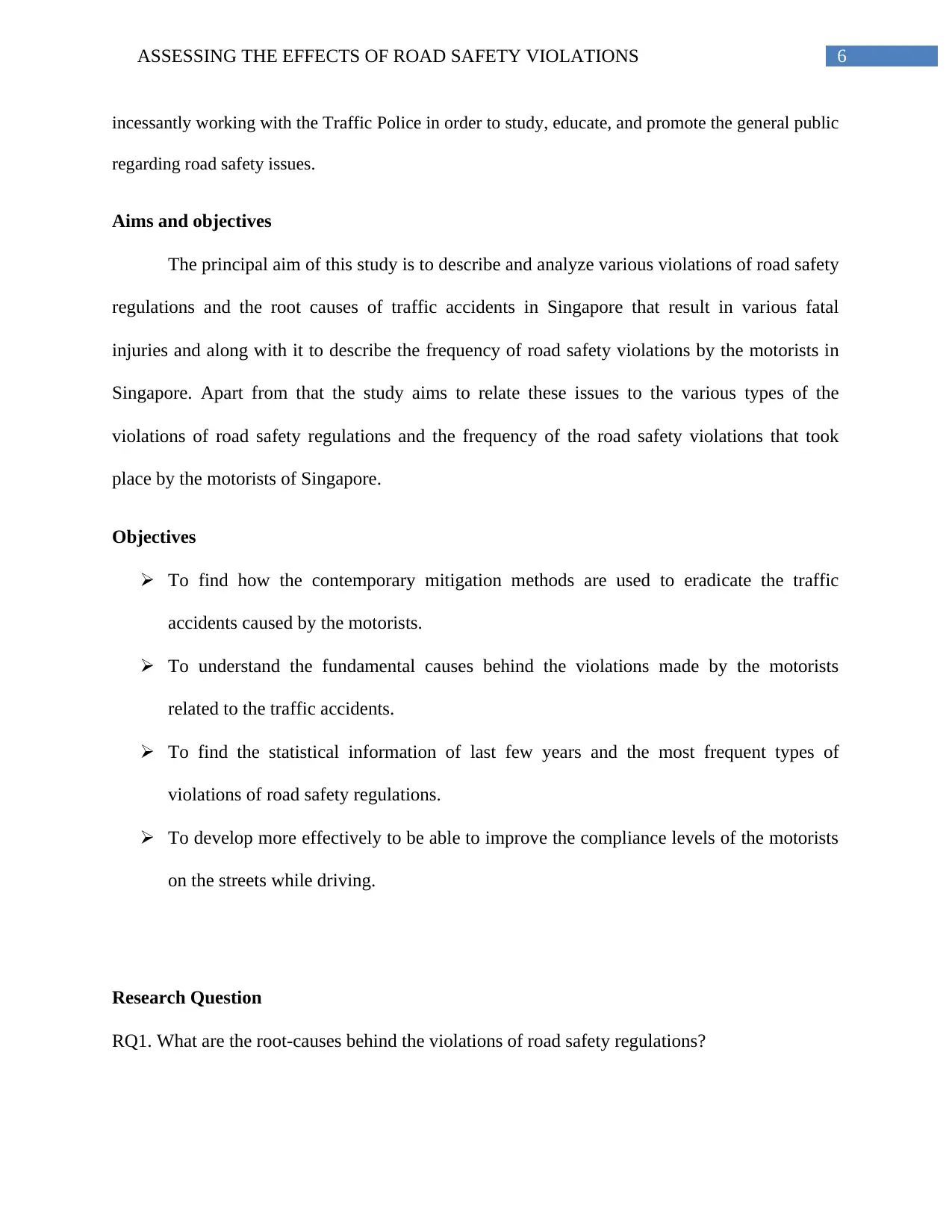
6ASSESSING THE EFFECTS OF ROAD SAFETY VIOLATIONS
incessantly working with the Traffic Police in order to study, educate, and promote the general public
regarding road safety issues.
Aims and objectives
The principal aim of this study is to describe and analyze various violations of road safety
regulations and the root causes of traffic accidents in Singapore that result in various fatal
injuries and along with it to describe the frequency of road safety violations by the motorists in
Singapore. Apart from that the study aims to relate these issues to the various types of the
violations of road safety regulations and the frequency of the road safety violations that took
place by the motorists of Singapore.
Objectives
To find how the contemporary mitigation methods are used to eradicate the traffic
accidents caused by the motorists.
To understand the fundamental causes behind the violations made by the motorists
related to the traffic accidents.
To find the statistical information of last few years and the most frequent types of
violations of road safety regulations.
To develop more effectively to be able to improve the compliance levels of the motorists
on the streets while driving.
Research Question
RQ1. What are the root-causes behind the violations of road safety regulations?
incessantly working with the Traffic Police in order to study, educate, and promote the general public
regarding road safety issues.
Aims and objectives
The principal aim of this study is to describe and analyze various violations of road safety
regulations and the root causes of traffic accidents in Singapore that result in various fatal
injuries and along with it to describe the frequency of road safety violations by the motorists in
Singapore. Apart from that the study aims to relate these issues to the various types of the
violations of road safety regulations and the frequency of the road safety violations that took
place by the motorists of Singapore.
Objectives
To find how the contemporary mitigation methods are used to eradicate the traffic
accidents caused by the motorists.
To understand the fundamental causes behind the violations made by the motorists
related to the traffic accidents.
To find the statistical information of last few years and the most frequent types of
violations of road safety regulations.
To develop more effectively to be able to improve the compliance levels of the motorists
on the streets while driving.
Research Question
RQ1. What are the root-causes behind the violations of road safety regulations?
Paraphrase This Document
Need a fresh take? Get an instant paraphrase of this document with our AI Paraphraser
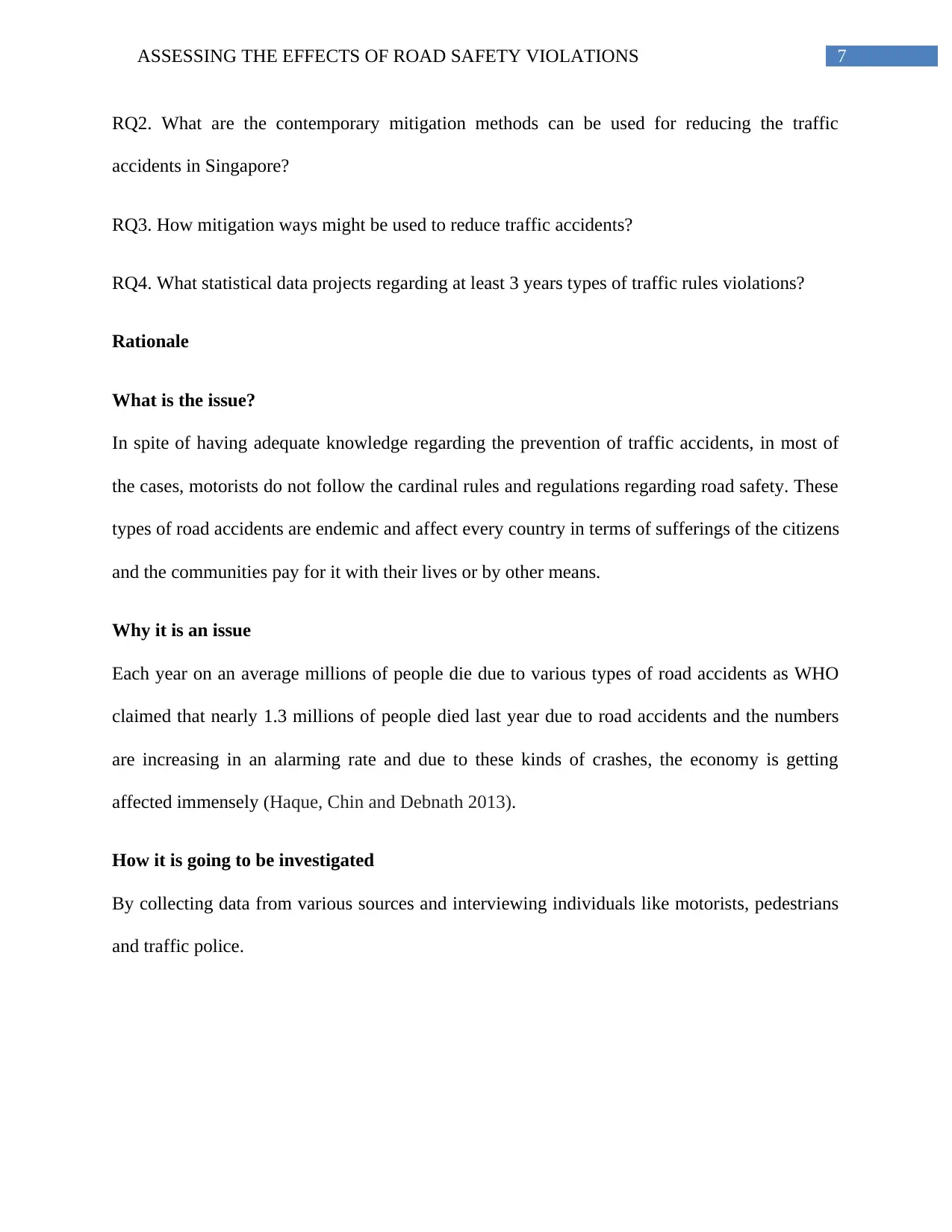
7ASSESSING THE EFFECTS OF ROAD SAFETY VIOLATIONS
RQ2. What are the contemporary mitigation methods can be used for reducing the traffic
accidents in Singapore?
RQ3. How mitigation ways might be used to reduce traffic accidents?
RQ4. What statistical data projects regarding at least 3 years types of traffic rules violations?
Rationale
What is the issue?
In spite of having adequate knowledge regarding the prevention of traffic accidents, in most of
the cases, motorists do not follow the cardinal rules and regulations regarding road safety. These
types of road accidents are endemic and affect every country in terms of sufferings of the citizens
and the communities pay for it with their lives or by other means.
Why it is an issue
Each year on an average millions of people die due to various types of road accidents as WHO
claimed that nearly 1.3 millions of people died last year due to road accidents and the numbers
are increasing in an alarming rate and due to these kinds of crashes, the economy is getting
affected immensely (Haque, Chin and Debnath 2013).
How it is going to be investigated
By collecting data from various sources and interviewing individuals like motorists, pedestrians
and traffic police.
RQ2. What are the contemporary mitigation methods can be used for reducing the traffic
accidents in Singapore?
RQ3. How mitigation ways might be used to reduce traffic accidents?
RQ4. What statistical data projects regarding at least 3 years types of traffic rules violations?
Rationale
What is the issue?
In spite of having adequate knowledge regarding the prevention of traffic accidents, in most of
the cases, motorists do not follow the cardinal rules and regulations regarding road safety. These
types of road accidents are endemic and affect every country in terms of sufferings of the citizens
and the communities pay for it with their lives or by other means.
Why it is an issue
Each year on an average millions of people die due to various types of road accidents as WHO
claimed that nearly 1.3 millions of people died last year due to road accidents and the numbers
are increasing in an alarming rate and due to these kinds of crashes, the economy is getting
affected immensely (Haque, Chin and Debnath 2013).
How it is going to be investigated
By collecting data from various sources and interviewing individuals like motorists, pedestrians
and traffic police.
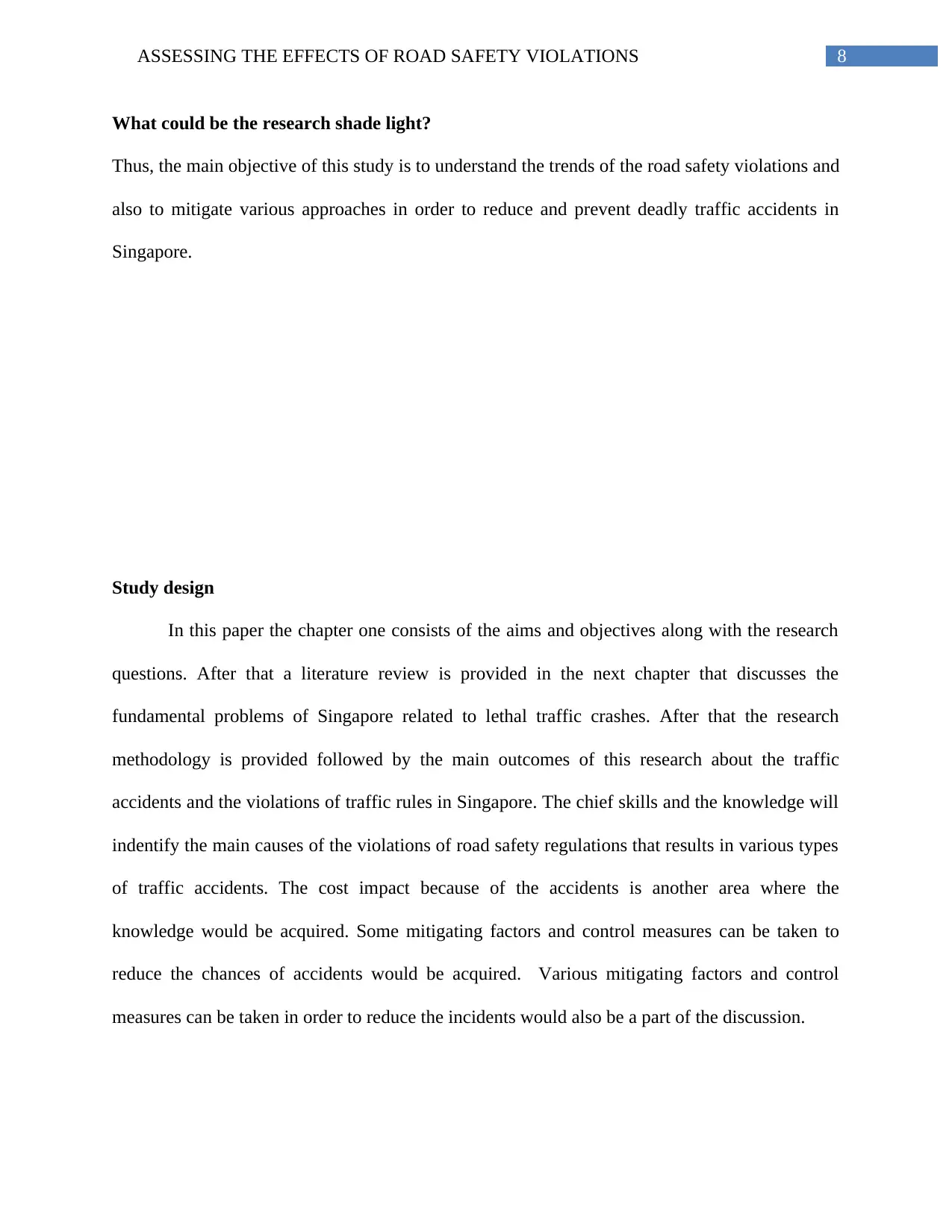
8ASSESSING THE EFFECTS OF ROAD SAFETY VIOLATIONS
What could be the research shade light?
Thus, the main objective of this study is to understand the trends of the road safety violations and
also to mitigate various approaches in order to reduce and prevent deadly traffic accidents in
Singapore.
Study design
In this paper the chapter one consists of the aims and objectives along with the research
questions. After that a literature review is provided in the next chapter that discusses the
fundamental problems of Singapore related to lethal traffic crashes. After that the research
methodology is provided followed by the main outcomes of this research about the traffic
accidents and the violations of traffic rules in Singapore. The chief skills and the knowledge will
indentify the main causes of the violations of road safety regulations that results in various types
of traffic accidents. The cost impact because of the accidents is another area where the
knowledge would be acquired. Some mitigating factors and control measures can be taken to
reduce the chances of accidents would be acquired. Various mitigating factors and control
measures can be taken in order to reduce the incidents would also be a part of the discussion.
What could be the research shade light?
Thus, the main objective of this study is to understand the trends of the road safety violations and
also to mitigate various approaches in order to reduce and prevent deadly traffic accidents in
Singapore.
Study design
In this paper the chapter one consists of the aims and objectives along with the research
questions. After that a literature review is provided in the next chapter that discusses the
fundamental problems of Singapore related to lethal traffic crashes. After that the research
methodology is provided followed by the main outcomes of this research about the traffic
accidents and the violations of traffic rules in Singapore. The chief skills and the knowledge will
indentify the main causes of the violations of road safety regulations that results in various types
of traffic accidents. The cost impact because of the accidents is another area where the
knowledge would be acquired. Some mitigating factors and control measures can be taken to
reduce the chances of accidents would be acquired. Various mitigating factors and control
measures can be taken in order to reduce the incidents would also be a part of the discussion.
⊘ This is a preview!⊘
Do you want full access?
Subscribe today to unlock all pages.

Trusted by 1+ million students worldwide

9ASSESSING THE EFFECTS OF ROAD SAFETY VIOLATIONS
Paraphrase This Document
Need a fresh take? Get an instant paraphrase of this document with our AI Paraphraser
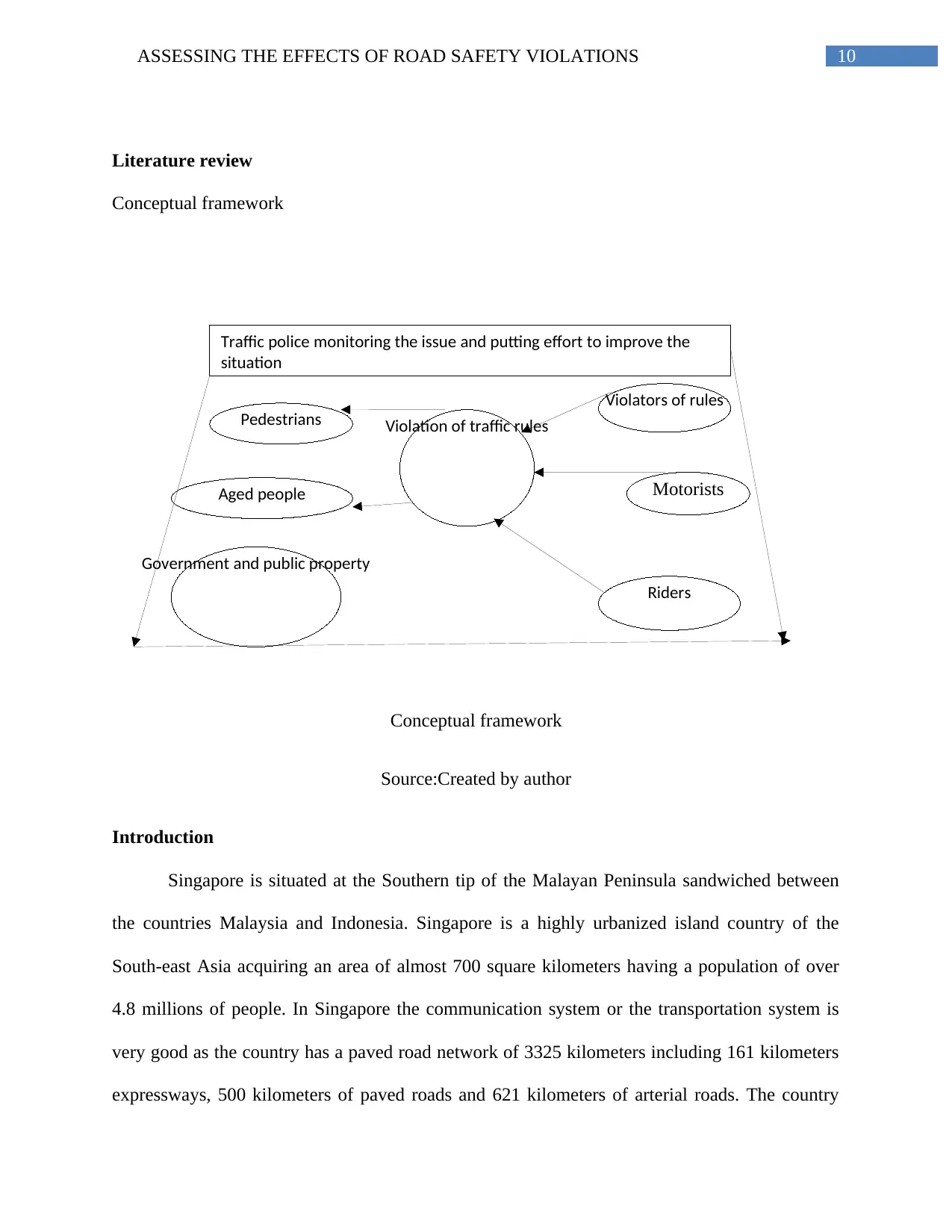
10ASSESSING THE EFFECTS OF ROAD SAFETY VIOLATIONS
Violation of traffic rules
Violators of rules
Riders
Pedestrians
Aged people
Government and public property
Traffic police monitoring the issue and putting effort to improve the
situation
Motorists
Literature review
Conceptual framework
Conceptual framework
Source:Created by author
Introduction
Singapore is situated at the Southern tip of the Malayan Peninsula sandwiched between
the countries Malaysia and Indonesia. Singapore is a highly urbanized island country of the
South-east Asia acquiring an area of almost 700 square kilometers having a population of over
4.8 millions of people. In Singapore the communication system or the transportation system is
very good as the country has a paved road network of 3325 kilometers including 161 kilometers
expressways, 500 kilometers of paved roads and 621 kilometers of arterial roads. The country
Violation of traffic rules
Violators of rules
Riders
Pedestrians
Aged people
Government and public property
Traffic police monitoring the issue and putting effort to improve the
situation
Motorists
Literature review
Conceptual framework
Conceptual framework
Source:Created by author
Introduction
Singapore is situated at the Southern tip of the Malayan Peninsula sandwiched between
the countries Malaysia and Indonesia. Singapore is a highly urbanized island country of the
South-east Asia acquiring an area of almost 700 square kilometers having a population of over
4.8 millions of people. In Singapore the communication system or the transportation system is
very good as the country has a paved road network of 3325 kilometers including 161 kilometers
expressways, 500 kilometers of paved roads and 621 kilometers of arterial roads. The country
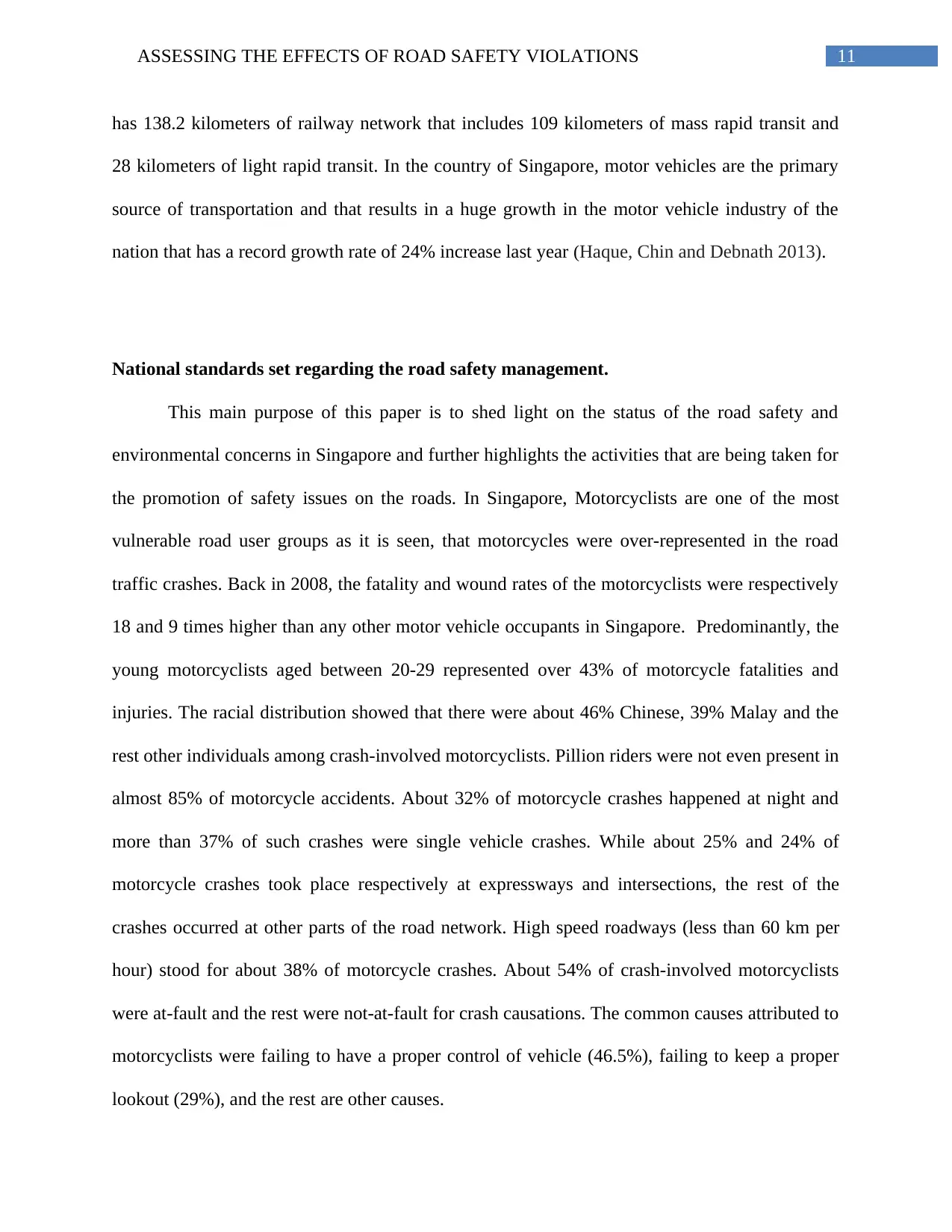
11ASSESSING THE EFFECTS OF ROAD SAFETY VIOLATIONS
has 138.2 kilometers of railway network that includes 109 kilometers of mass rapid transit and
28 kilometers of light rapid transit. In the country of Singapore, motor vehicles are the primary
source of transportation and that results in a huge growth in the motor vehicle industry of the
nation that has a record growth rate of 24% increase last year (Haque, Chin and Debnath 2013).
National standards set regarding the road safety management.
This main purpose of this paper is to shed light on the status of the road safety and
environmental concerns in Singapore and further highlights the activities that are being taken for
the promotion of safety issues on the roads. In Singapore, Motorcyclists are one of the most
vulnerable road user groups as it is seen, that motorcycles were over-represented in the road
traffic crashes. Back in 2008, the fatality and wound rates of the motorcyclists were respectively
18 and 9 times higher than any other motor vehicle occupants in Singapore. Predominantly, the
young motorcyclists aged between 20-29 represented over 43% of motorcycle fatalities and
injuries. The racial distribution showed that there were about 46% Chinese, 39% Malay and the
rest other individuals among crash-involved motorcyclists. Pillion riders were not even present in
almost 85% of motorcycle accidents. About 32% of motorcycle crashes happened at night and
more than 37% of such crashes were single vehicle crashes. While about 25% and 24% of
motorcycle crashes took place respectively at expressways and intersections, the rest of the
crashes occurred at other parts of the road network. High speed roadways (less than 60 km per
hour) stood for about 38% of motorcycle crashes. About 54% of crash-involved motorcyclists
were at-fault and the rest were not-at-fault for crash causations. The common causes attributed to
motorcyclists were failing to have a proper control of vehicle (46.5%), failing to keep a proper
lookout (29%), and the rest are other causes.
has 138.2 kilometers of railway network that includes 109 kilometers of mass rapid transit and
28 kilometers of light rapid transit. In the country of Singapore, motor vehicles are the primary
source of transportation and that results in a huge growth in the motor vehicle industry of the
nation that has a record growth rate of 24% increase last year (Haque, Chin and Debnath 2013).
National standards set regarding the road safety management.
This main purpose of this paper is to shed light on the status of the road safety and
environmental concerns in Singapore and further highlights the activities that are being taken for
the promotion of safety issues on the roads. In Singapore, Motorcyclists are one of the most
vulnerable road user groups as it is seen, that motorcycles were over-represented in the road
traffic crashes. Back in 2008, the fatality and wound rates of the motorcyclists were respectively
18 and 9 times higher than any other motor vehicle occupants in Singapore. Predominantly, the
young motorcyclists aged between 20-29 represented over 43% of motorcycle fatalities and
injuries. The racial distribution showed that there were about 46% Chinese, 39% Malay and the
rest other individuals among crash-involved motorcyclists. Pillion riders were not even present in
almost 85% of motorcycle accidents. About 32% of motorcycle crashes happened at night and
more than 37% of such crashes were single vehicle crashes. While about 25% and 24% of
motorcycle crashes took place respectively at expressways and intersections, the rest of the
crashes occurred at other parts of the road network. High speed roadways (less than 60 km per
hour) stood for about 38% of motorcycle crashes. About 54% of crash-involved motorcyclists
were at-fault and the rest were not-at-fault for crash causations. The common causes attributed to
motorcyclists were failing to have a proper control of vehicle (46.5%), failing to keep a proper
lookout (29%), and the rest are other causes.
⊘ This is a preview!⊘
Do you want full access?
Subscribe today to unlock all pages.

Trusted by 1+ million students worldwide
1 out of 48
Related Documents
Your All-in-One AI-Powered Toolkit for Academic Success.
+13062052269
info@desklib.com
Available 24*7 on WhatsApp / Email
![[object Object]](/_next/static/media/star-bottom.7253800d.svg)
Unlock your academic potential
Copyright © 2020–2025 A2Z Services. All Rights Reserved. Developed and managed by ZUCOL.





